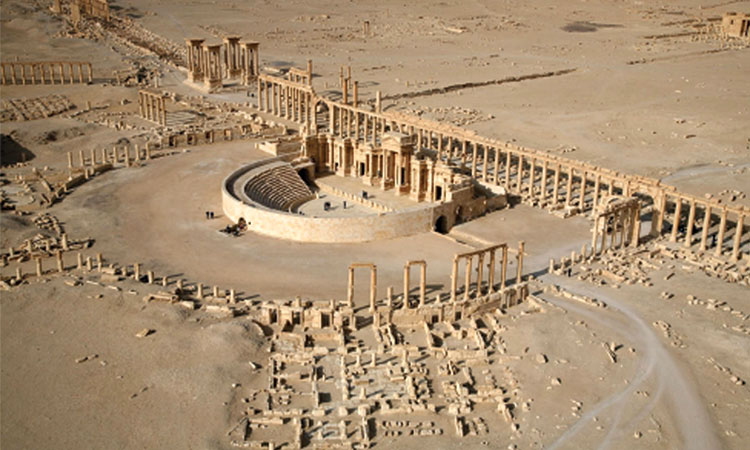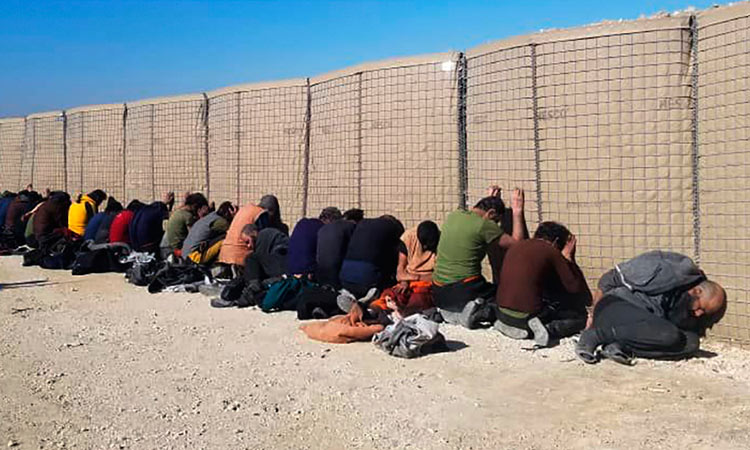The dark side of social networking sites

Michael Jansen
The author, a well-respected observer of Middle East affairs, has three books on the Arab-Israeli conflict.

A general view of the ancient city of Palmyra in Syria.
The 1991 and 2003 US wars on Iraq launched massive pillaging of the Eastern Arab World’s rich cultural heritage because that country could no longer effectively police its 10,000 archaeological sites, benefitting foreign and local looters. While occupying Mosul and a wide swath of territory in northern Iraq, Daesh destroyed several of the most important ancient Mesopotamian sites, blasted and bulldozed iconic mosques and churches, and looted artefacts. The eight-year war in Syria has not only damaged and destroyed major heritage sites but also swelled the host of looters.
In both countries Daesh and allied fighters have stripped treasures from established and unexplored sites and sold them to illicit dealers to fund their insurgencies, transforming them into “blood artefacts,” like the “blood diamonds” that have fuelled half a dozen African wars. Soldiers, farmers, and urban folk have dug up artefacts to sell for personal profit.
While looting of cultural property during warfare is an ancient practice, Amr al-Azm and Katie Paul made the point in an August 2018 issue of World Politics Review that Daesh has been the first terrorist group in history to exploit the riches of the ancient world. Daesh has commodified “cultural heritage as a resource that could simultaneously provide financial sustainability and propaganda value, compounding the psychological impact of its terrorism on civilian populations.” In other words, while earning millions of dollars, Daesh attempted to undermine the historical and cultural identities of the people it occupied in order to make it easier to convert them to the brutal cult’s ideology and cause.
Daesh and other heritage predators could not have succeeded if there had been no smugglers, middle men, retail dealers and customers. While E-bay and other internet platforms have been advertising and selling stolen artefacts for years, Facebook has reached the top in cultural heritage commerce. Azm and Paul reported that Facebook has become “the most high profile of the social media platforms that have been used as vehicles for the sale of illicit artefacts.”
Facebook and WhatsApp, they say, “fall short of providing the means to report and remove pages and groups that engage in the trafficking of cultural property” although these platforms have managed to reduce sales of drugs and weapons. Azm and Paul also reveal that Facebook users involved in the trade provide information and instructions on identifying potential digs and on how to carry out pillage from subterranean sites. Traders also post photos of popular items and suggest high prices in order to encourage field workers to search for them and put them on sale. Traffickers operate across this region and elsewhere while buyers are mainly in the West: the US, UK, Germany, France, and Belgium. Looting of some items takes place on order.
Although the Azm-Paul article appeared last August, it has taken mainstream media outlets until this month to take up Facebook’s role in pillage. The first I learnt of its involvement was on May 2nd when the BBC broadcast material gathered by Steve Swann revealing that Facebook has removed 49 groups dealing in stolen antiquities as a result of the BBC’s interest in this issue. However, Azm told Swann during an interview in Istanbul that Facebook still hosts looters and traffickers. Furthermore, despite the defeat of Daesh in Syria and Iraq, artefacts continue to be smuggled into Turkey and traded on the international antiquities black market. Along with Munich and Zurich — Istanbul has long been a major global hub for this illegal trade.
Other media picked up on the BBC story. On May 9th, the New York Times’ Karen Zraick caught up with the BBC, again citing Azm as the source of its information. Azm said that although Facebook claims to have taken down some groups, there remain “at least 90 Facebook groups, most in Arabic, connected to the trade in Middle Eastern antiquities, with tens of thousands of members.”
A Facebook spokeswoman said that the company is striving to detect and remove illegal content. Azm warned Facebook about this trade in 2014 but, apparently, nothing was done to intervene and end it. Azm argued that instead of removing groups from the platform, the firm should notify investigators and law enforcement in order to identify and track looted items, apprehend thieves and traffickers, and recover artefacts. Facebook is already under fire for providing a market place for poached ivory as well as arms.
Looting in Iraq was largely restricted until the 1991 war due the fact that the centre, Baghdad, had been weakened by sanctions, the war and the US-encouraged Shia and Kurdish rebellions put down by the Iraqi army. After 2003 pillage reached an industrial level involving local entrepreneurs who transported local farmers and unemployed urban workers to archaeological sites and instructed them to dig for artifacts. US occupation forces did nothing to halt this enterprise from April 2003 through the end of 2011 when most US troops pulled out. Since then networks of traffickers in Mesopotamian art and antiquities, already safely based in Turkey, expanded their predations to Syria.
Washington adopted a cavalier attitude to this process after former Defence Secretary Donald Rumsfeld responded to criticism over the looting of the Iraq Museum in early April 2003 by saying, “Stuff happens.” This seems to be the line adopted by uncultured and uneducated owners of Facebook and other online platforms these days. Tragically, every site that is targeted and every item that is looted and sold to international middlemen and collectors deprives the people of the region and the inhabitants of the world of the stories of civilisations that long ago flourished in this part of the world and elsewhere.







